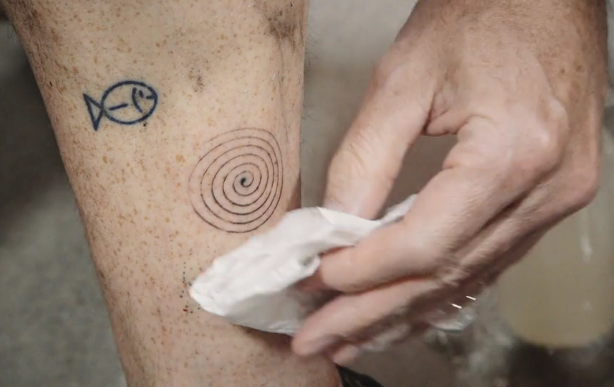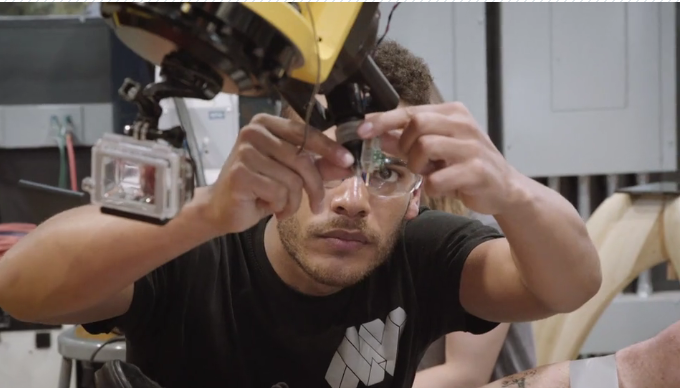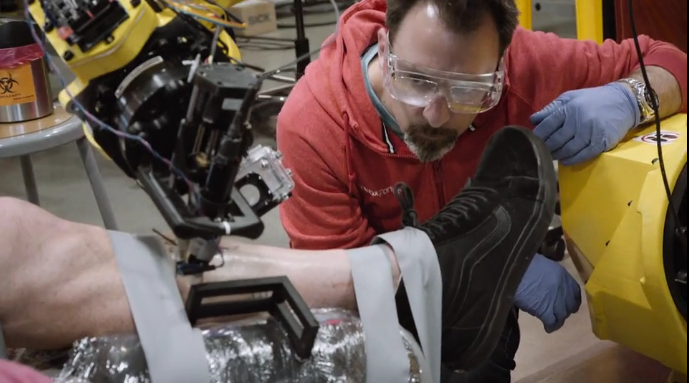 Oh, how quickly technology develops. It’s a common refrain around here, but it’s one thing to hear about the fast progression of 3D printing in general and another to watch a specific invention go from rudimentary prototype to polished industrial machine in a short amount of time. Late last year, we reported on a French tattoo studio that hacked a MakerBot printer and turned it into a tattooing machine. At the time, it was still a pretty rough, if cool, concept – tatoué, as Appropriate Audiences named their invention, was able to tattoo a few basic shapes onto a person who inserted his or her arm carefully into the printer, but there wasn’t much versatility in terms of what kind of designs or parts of the body could be tattooed.
Oh, how quickly technology develops. It’s a common refrain around here, but it’s one thing to hear about the fast progression of 3D printing in general and another to watch a specific invention go from rudimentary prototype to polished industrial machine in a short amount of time. Late last year, we reported on a French tattoo studio that hacked a MakerBot printer and turned it into a tattooing machine. At the time, it was still a pretty rough, if cool, concept – tatoué, as Appropriate Audiences named their invention, was able to tattoo a few basic shapes onto a person who inserted his or her arm carefully into the printer, but there wasn’t much versatility in terms of what kind of designs or parts of the body could be tattooed.
The first iteration of the tattoo printer was developed in 2014; this year, Appropriate Audiences took it to Autodesk’s Pier 9 workshop, and boy, does it look different now. With help from Autodesk’s Applied Research Lab, tatoué has gone from a modified 3D printer to a giant robot arm that can tattoo anywhere a human tattoo artist can.
“Our researchers really focused on this more intimate relationship that people are likely to have with machines in the not too distant future,” said David Thomasson, Principal Research Engineer at the Applied Research Lab. “This project is really pushing that to the limit.”
After intense research and consultations with outside experts on health and safety, the team went ahead and set up for the first tattoo to be performed by tatoué’s new incarnation. A 3D scan was taken of the subject’s leg (Appropriate Audience’s Pierre Emm volunteered to be the guinea pig) and imported into Dynamo, Autodesk’s graphical parametric design software. The tattoo design, a simple spiral, was applied to the model, and the information was exported to the robot as code so that it would know exactly what and where to tattoo.
 It worked perfectly (much to Emm’s relief, I’m sure). According to Thomasson, they’re hoping to now work on open-sourcing the technology with help from other research institutions and universities.
It worked perfectly (much to Emm’s relief, I’m sure). According to Thomasson, they’re hoping to now work on open-sourcing the technology with help from other research institutions and universities.
It’s not an entirely human-free technology – while the robot is doing the tattooing, a person is still controlling the robot’s speed. The person getting the tattoo also has an emergency stop option, which is reassuring. I have several tattoos, and after my first one I wasn’t intimidated by the tattoo needle anymore – but a giant robot with a needle is a bit different than a human with a needle. I have serious respect for Emm; it had to be more than a little unnerving being duct-taped to a chair while a massive robotic arm performed its first tattooing procedure. He ended up with a lovely result, though!
The pluses of a robotic tattooing machine include the assurance that you’ll get exactly the design you expect, which is unfortunately not always the case with tattoos done by humans. It’s an art form, though, one that people spend years perfecting, and I’d hate to see artists replaced by machines. I don’t think that’s too much of a risk; the human element of tattooing is something that I think is important to a lot of people, myself included.
Still, what Autodesk and Appropriate Audiences have done is pretty amazing, and I’m very curious to see where it will go from here – particularly if they open source the design. Watch tatoué at work below, and discuss further in the Tattooing 3D Printer forum over at 3DPB.com.
Subscribe to Our Email Newsletter
Stay up-to-date on all the latest news from the 3D printing industry and receive information and offers from third party vendors.
You May Also Like
Precision at the Microscale: UK Researchers Advance Medical Devices with BMF’s 3D Printing Tech
University of Nottingham researchers are using Boston Micro Fabrication‘s (BMF) 3D printing technology to develop medical devices that improve compatibility with human tissue. Funded by a UK grant, this project...
3D Printing Webinar and Event Roundup: April 21, 2024
It’s another busy week of webinars and events, starting with Hannover Messe in Germany and continuing with Metalcasting Congress, Chinaplas, TechBlick’s Innovation Festival, and more. Stratasys continues its advanced training...
3D Printing Webinar and Event Roundup: March 17, 2024
It’s another busy week of webinars and events, including SALMED 2024 and AM Forum in Berlin. Stratasys continues its in-person training and is offering two webinars, ASTM is holding a...
3D Printed Micro Antenna is 15% Smaller and 6X Lighter
Horizon Microtechnologies has achieved success in creating a high-frequency D-Band horn antenna through micro 3D printing. However, this achievement did not rely solely on 3D printing; it involved a combination...































